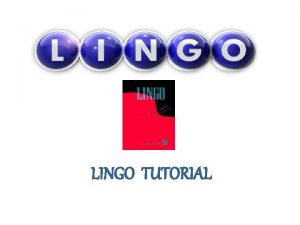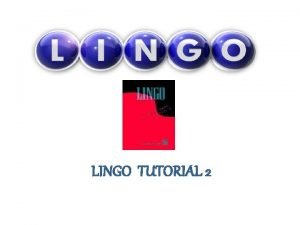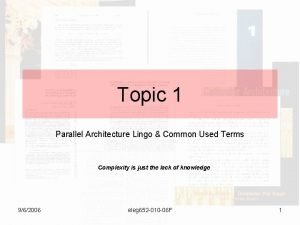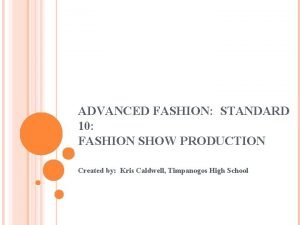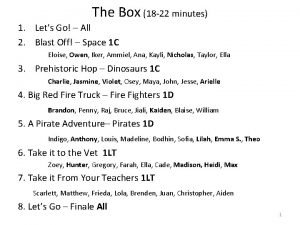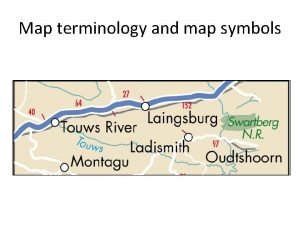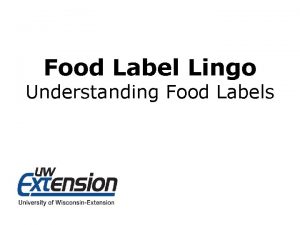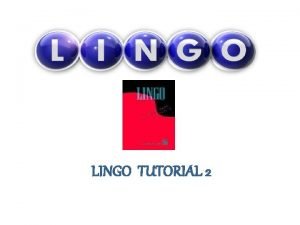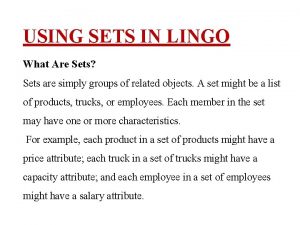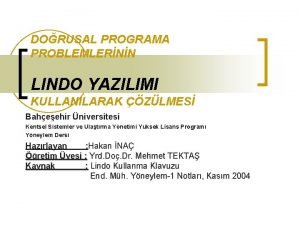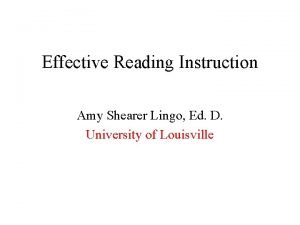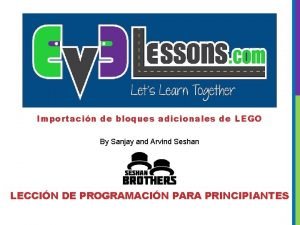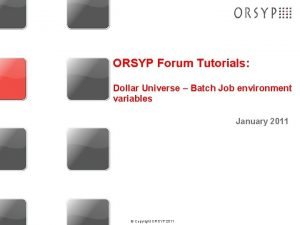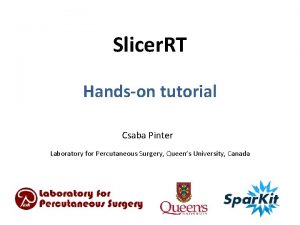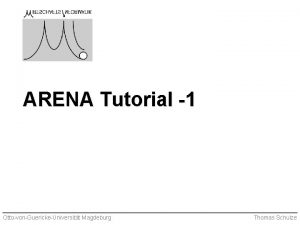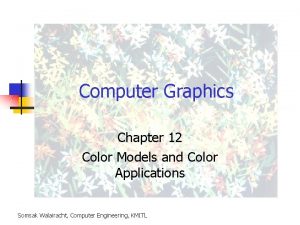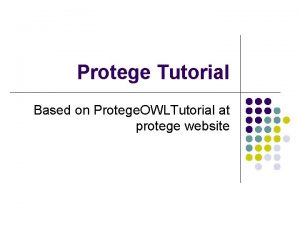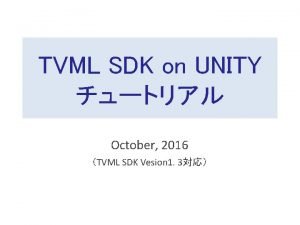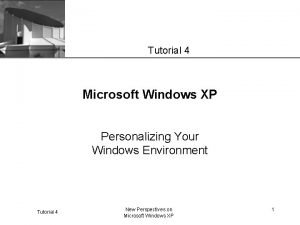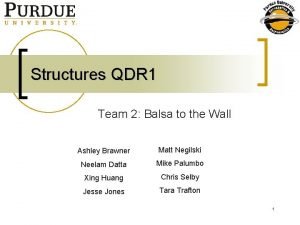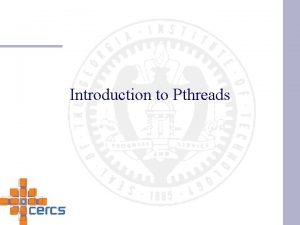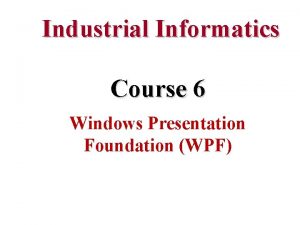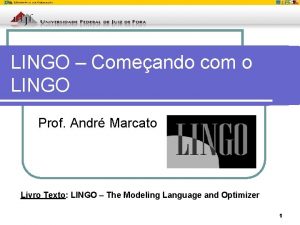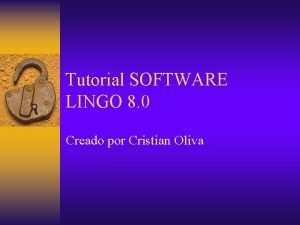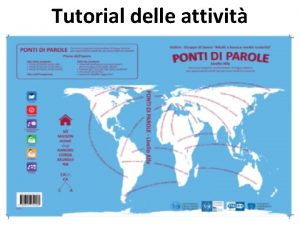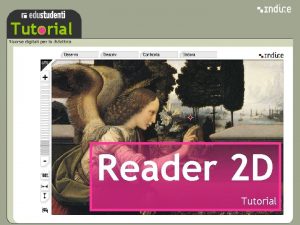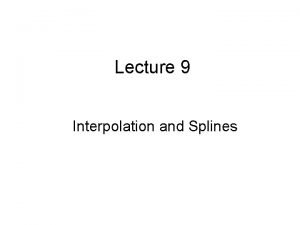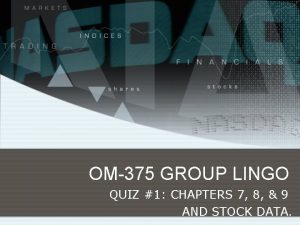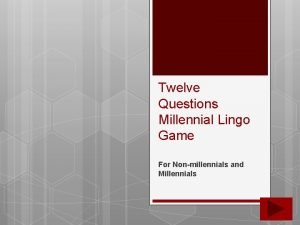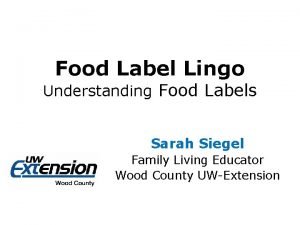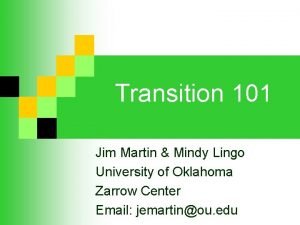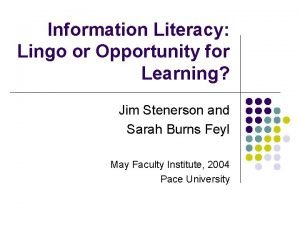LINGO TUTORIAL WHAT IS LINGO LINGO is a



























- Slides: 27

LINGO TUTORIAL

WHAT IS LINGO : • LINGO is a software tool designed to efficiently build and solve linear, nonlinear, and integer optimization models. CREATING A LINGO MODEL: • An optimization model consists of three parts: • Objective function: This is single formula that describes exactly what the model should optimize. • Variables: These are the quantities that can be changed to produce the optimal value of the objective function. • Constraints: These are formulas that define the limits on the values of the variables.


PRIMARY RULES • Comments in the model are initiated with an exclamation point (!) and appear in green text. • LINGO specified operators and functions appear in blue text. • All other text is shown in black. • Each LINGO statement must end in a semi-colon (; ). • Variable names are not case-sensitive and must begin with a letter (A-Z). Other • characters in the variable name may be letters, numbers (0 -9), or the underscore character (_). • Variable names can be up to 32 characters in length.

LINGO OPERATORS: • Exponentiation: ^ • Multiplication: * • Division: / • Addition: + • Subtraction: - • The relational operators are used when defining the constraints for a model. They are as follows: • The expression is equal: = • The left side of the expression is less than or equal to the right side: <= • The left side of the expression is greater than or equal to the right side: >=

• COMMON LINGO ERROR MESSAGES: • Unable to open file: filename Retype filename correctly • Invalid input: A syntax error has occurred Check the line LINGO suggests for missing semi-colons, etc. • Unmatched parenthesis Close the parenthesis set • No relational operator found Make sure all constraints contain =, <=, >=

• Unterminated condition Put a colon at the end of each conditional statement in a set operator • The model’s dimensions exceed the capacity of this version • No feasible solution found Check model’s consistency and constraints • Unbounded solution Add constraints • Unrecognized variable name: variable name Check spelling

A SIMPLE EXAMPLE: MAX = 3*x 1+x 2; x 1 <= 4; x 1+x 2 <= 7; Once the LINGO model has been entered into the LINGO Model window, the model can be solved by clicking the Solve button on the toolbar, by selecting LINGO Solve from the menus.

• If no errors are found, then the LINGO Solver Status window appears.

REPORTS: LINGO will notify you of any errors it has encountered. The best way to get information about these errors is to consult the Error Messages section in the software’s proprietary tutorial.

This window shows the values of each variable that will produce the optimal value of the objective function. The reduced cost for any variable that is included in the optimal solution is always zero. For variables not included in the optimal solution, the reduced cost shows how much the value of the objective function would decrease (for a MAX problem) or increase (for a MIN problem) if one unit of that variable were to be included in the solution. For example, if the reduced cost of a certain variable was 5, then the optimal value of the MAX problem would decrease by 5 units if 1 unit of the variable were to be added.





A SIMPLE EXAMPLE: A cookie store can produce drop cookies and decorated cookies , which sell for $1 and $1. 50 apiece , respectively. The two bakers each work 8 hours per day and can produce up to 400 drop cookies and 200 decorated cookies. It takes 1 minute to produce each drop cookie and 3 minutes to produce each decorated cookie. What combination of cookies produced will maximize the baker's profit ?

SOLUTION: Model: MAX = 1*Drop + 1. 5*Deco; Drop <= 400; Deco <= 200; 1/60*Drop + 3/60*Deco <=16; Drop>=0; Deco>=0;








New 1. File Menu Commands: Opens a new model window. Opens an existing model previously saved to disk. Saves the contents of the current window to disk. Save As Saves the contents of the current window to a new name. Closes the current window. Prints the contents of the current window. Print Setup Configures your printer. Print Preview Displays the contents of the current window as it would appear if printed Log Output Opens a log file for logging output to the command window. Take Commands Runs a command script contained in a file. Export File Exports a model in MPS or MPI file format. License Prompts you for a new license password to upgrade your system. Database User Info Prompts you for a user id and password for database access via the @ODBC() function. Exits LINGO.

2. Edit Menu Commands: Undoes the last change. Redoes the last undo command. Cuts the current selection from the document. Copy Copies the current selection to the clipboard. Pastes the contents of the clipboard into the document. Paste Special Pastes the contents of the clipboard into the document, allowing choice as to how the object is pasted. Select All Selects the entire contents of the current window. Find Searches the document for the occurrence of a specified text string. Find Next Repeats the find operation for the last string specified. Replaces a specified text string with a new string. Go To Line Moves the cursor to a specified line number. Match Parenthesis Finds the parenthesis that closes a selected parenthesis. Paste Function Pastes a template of a selected LINGO @function. Select Font Specifies a font for a selected block of text. Insert New Object Embeds an OLE (Object Linking and Embedding) object into the document. Links Controls the links to external objects in your document. Object Properties Specifies the properties of a selected, embedded object.

3. LINGO Menu Commands: Solves the model in the current window. Solution Generates a solution report window for the current model. Range Generates a range analysis report for the current window. Options Sets system options. Generates the algebraic representation for the current model. Picture Displays a graphical picture of a model in matrix form. Debug Tracks down formulation errors in infeasible and unbounded linear programs. Model Statistics Displays a brief report regarding the technical detail of a model. Look Generates a formulation report for the current window.
 Lingo tutorial
Lingo tutorial Lingo @gin
Lingo @gin Architecture lingo
Architecture lingo Fashion runway terms
Fashion runway terms Pirate lingo
Pirate lingo Map symbols and meanings
Map symbols and meanings Lingo boingo
Lingo boingo Label lingo
Label lingo Lingo model example
Lingo model example Lingo syntax
Lingo syntax Lingo sets
Lingo sets Lingo formatı
Lingo formatı Amy lingo
Amy lingo Yarrie lingo
Yarrie lingo Know the lingo worksheet answers
Know the lingo worksheet answers Spike prime tutorial
Spike prime tutorial Dollar universe tutorial
Dollar universe tutorial Tutorial pinter
Tutorial pinter Thomas schulze magdeburg
Thomas schulze magdeburg Intuitive color concepts in computer graphics
Intuitive color concepts in computer graphics Tutorial protege
Tutorial protege Tutorial on google classroom
Tutorial on google classroom Tvml tutorial
Tvml tutorial Windows xp custom
Windows xp custom Aae glass tutorial
Aae glass tutorial Pthreads tutorial
Pthreads tutorial Wpf tutorial point
Wpf tutorial point Verb tense tutorial
Verb tense tutorial
